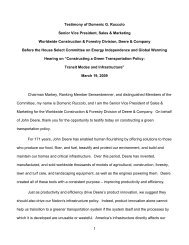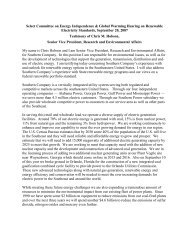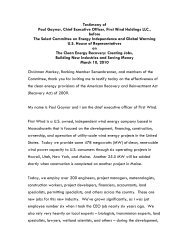Tom Troxel - The Select Committee for Energy Independence and ...
Tom Troxel - The Select Committee for Energy Independence and ...
Tom Troxel - The Select Committee for Energy Independence and ...
Create successful ePaper yourself
Turn your PDF publications into a flip-book with our unique Google optimized e-Paper software.
Testimony of<br />
Thomas A. <strong>Troxel</strong><br />
Director, Black Hills Forest Resource Association<br />
Be<strong>for</strong>e the House of Representatives <strong>Select</strong> <strong>Committee</strong> on<br />
<strong>Energy</strong> <strong>Independence</strong> <strong>and</strong> Global Warming<br />
June 18, 2009<br />
Chairman Markey, Ranking Member Sensenbrenner, Representative Herseth S<strong>and</strong>lin, <strong>and</strong> members of the<br />
<strong>Select</strong> <strong>Committee</strong>, thank you <strong>for</strong> the opportunity to give testimony on the important topic of <strong>for</strong>ests <strong>and</strong><br />
climate change. My name is Thomas A. <strong>Troxel</strong>, <strong>and</strong> I am here today representing the Black Hills Forest<br />
Resource Association, a trade association representing <strong>for</strong>est products companies in the Black Hills region<br />
of South Dakota <strong>and</strong> Wyoming.<br />
Background<br />
I’m testifying today, not as an expert on global climate change, but as a <strong>for</strong>ester with 35 years of experience<br />
in the Intermountain West. I currently work primarily with the Black Hills National Forest, which lies in<br />
western South Dakota <strong>and</strong> northeastern Wyoming, <strong>and</strong> with the other national <strong>for</strong>ests in Wyoming <strong>and</strong><br />
Colorado, which comprise the Forest Service’s Rocky Mountain Region. <strong>The</strong>se <strong>for</strong>ests are comprised<br />
primarily of ponderosa pine, lodgepole pine, Engelmann spruce, true firs, <strong>and</strong> aspen, each of which occupy<br />
specific habitats <strong>and</strong> require individual management strategies.<br />
How will changes in temperatures, precipitation <strong>and</strong> weather patterns affect <strong>for</strong>estry?<br />
Forests have evolved over millions of years in association with many past changes in climate. For instance,<br />
the current <strong>for</strong>ests of the Black Hills are a remnant of a boreal <strong>for</strong>est that covered all of South Dakota only<br />
10,000 years ago. Looking ahead, climate change will have varying effects on <strong>for</strong>estry depending on the<br />
specific change <strong>and</strong> the particular species of trees. Most scientists now predict a warmer, drier climate. To<br />
the extent that climate change will cause a warmer, drier climate, it will likely stress <strong>for</strong>ests, making them<br />
more vulnerable to insect <strong>and</strong> disease outbreaks. Similarly, in a warmer, drier climate, wildfires will likely
ecome more frequent <strong>and</strong> intense, cost more to suppress, <strong>and</strong> have greater impacts on air <strong>and</strong> water<br />
quality, wildlife habitat <strong>and</strong> infrastructure.<br />
To underst<strong>and</strong> how this would affect <strong>for</strong>ests in the future, consider the effects of below average<br />
precipitation <strong>for</strong> most of the last 10 years over much of the western United States. Since 2000, <strong>for</strong>est fires<br />
have burned 184,000 acres of the Black Hills NF, including the Jasper Fire, the largest fire in the recorded<br />
history of South Dakota. In August 2000, with hot, dry weather conditions, <strong>and</strong> record low vegetation<br />
moisture, the Jasper Fire burned 83,500 acres (including 50,000 acres in just a few hours on August 26 th )<br />
<strong>and</strong> cost $11.5 million to suppress. In 2002, the Hayman Fire burned 138,000 acres southwest of Denver,<br />
Colorado, making it the largest fire in the recorded history of Colorado, <strong>and</strong> cost $39 million to suppress.<br />
Also in 2002, the Missionary Ridge fire burned 70,000 acres in southwest Colorado, at a cost of $90<br />
million to suppress <strong>and</strong> another $9 million in rehabilitation costs.<br />
Since the late 1990s, a mountain pine beetle epidemic has affected over 200,000 acres in the Black Hills,<br />
<strong>and</strong> is still killing over 100,000 new trees each year. During the same period, a massive mountain pine<br />
beetle epidemic has exploded in Colorado <strong>and</strong> Wyoming, killing nearly 2 million acres of <strong>for</strong>ests. Forest<br />
entomologists predict that by the time the beetle has finished, it will have killed 80-90% of the mature<br />
lodgepole trees in Colorado. Mature trees account <strong>for</strong> 90% of the lodgepoles. While beetle infestations are<br />
part of the natural order of these <strong>for</strong>est, the current epidemic has exceeded anyone’s prediction.<br />
In addition to the effects on the <strong>for</strong>ests themselves, fires <strong>and</strong> mountain pine beetle epidemics will have<br />
significant effects on water quality, water quantity, wildlife populations <strong>and</strong> habitat, recreation, critical<br />
infrastructure, <strong>and</strong> the safety of people <strong>and</strong> communities.<br />
How will threats by pests change or grow due to climate change?<br />
Climate is one of the most important factors affecting mountain pine beetle populations. Typically, higher<br />
elevation <strong>and</strong> northern latitude <strong>for</strong>ests experience extreme cold periods where air temperatures hover at<br />
minus 30-40°F <strong>for</strong> several or more weeks in winter. Under such temperatures over-wintering beetles or<br />
2
larvae experience significant mortality. Similarly, cool moist summers can inhibit beetle activity <strong>and</strong> larval<br />
development <strong>and</strong> increase the effects of fungal pathogens. Under warmer <strong>and</strong> drier climatic conditions,<br />
beetle populations respond with less winter mortality <strong>and</strong> faster, more efficient reproductive cycles.<br />
Under the “average” climatic conditions of the past century, mountain pine beetles exist as an endemic<br />
population within pine <strong>for</strong>ests, colonizing <strong>and</strong> killing trees that are unable or incapable of defending<br />
themselves due to a variety of physiological, genetic or environmental factors. Trees that are not growing<br />
vigorously due to old age, competition, poor growing conditions, drought, fire or other damage are the trees<br />
most likely to be attacked by bark beetles.<br />
<strong>The</strong> availability of suitable host trees is an equally important factor that influences mountain pine beetle<br />
populations. Susceptibility to mountain pine beetles is closely related to tree vigor, which is related to st<strong>and</strong><br />
density. As st<strong>and</strong> density increases, the amount of competition between individual trees within the st<strong>and</strong><br />
<strong>for</strong> water, sunlight <strong>and</strong> nutrients, will also increase. A warmer, drier climate will cause additional stress to<br />
<strong>for</strong>ests, making them even more vulnerable to insect <strong>and</strong> disease outbreaks.<br />
A combination of mild winters, early springs <strong>and</strong> longer summers present perfect conditions <strong>for</strong> mountain<br />
pine beetle survival <strong>and</strong> reproduction. When combined with a l<strong>and</strong>scape dominated by st<strong>and</strong>s of mature<br />
host trees, which are stressed from overstocking <strong>and</strong> drought, the conditions <strong>for</strong> an epidemic are present. If<br />
the climatic conditions that favor bark beetles persist, this epidemic will last as long as there are host trees<br />
available to eat. When epidemic populations develop, trees that originally exhibited resistance to pest<br />
attack can succumb to the sheer numbers of beetles. That is exactly the scenario now playing out in <strong>for</strong>ests<br />
in the Black Hills, Wyoming, Colorado, <strong>and</strong> across the West.<br />
How can <strong>for</strong>estry help produce low carbon energy <strong>and</strong> sequester carbon?<br />
Forestry can help produce low carbon energy <strong>and</strong> sequester carbon through 1) Management Strategies <strong>for</strong><br />
Sequestration, 2) Reducing Fires <strong>and</strong> Insect Epidemics, 3) Substitution of Biomass <strong>for</strong> Fossil Fuels, <strong>and</strong> 4)<br />
Utilization of Wood Products.<br />
3
1) Management Strategies <strong>for</strong> Sequestration - Forests play a crucial role when considering ways to address<br />
the increase in atmospheric carbon dioxide levels <strong>and</strong> potential climate change. Forests are better at storing<br />
carbon than any other l<strong>and</strong> cover. It is estimated that U.S. <strong>for</strong>ests sequester about 200 million metric tons<br />
of carbon per year, which offsets about 10% of the industrial emissions of greenhouse gases.<br />
Although there is debate on this issue, it seems clear from modeling studies that, in the long run, properly<br />
managed <strong>for</strong>ests that incorporate a sequence of harvests result in more carbon sequestered than a <strong>for</strong>est left<br />
unmanaged. This is because rapidly growing young <strong>for</strong>ests are more efficient in carbon sequestration. Old<br />
<strong>for</strong>ests store more carbon, but as they age <strong>and</strong> are taken over by insects <strong>and</strong> disease the net uptake of carbon<br />
can diminish to zero as carbon lost in respiration <strong>and</strong> decomposition becomes similar to the rates of carbon<br />
uptake. Harvesting results in an immediate decline in carbon storage, but the significance of this depends<br />
on the fate of carbon in the various harvested products, <strong>and</strong> the environmental <strong>and</strong> carbon costs of using<br />
alternative products, such as steel, concrete, or aluminum, whose manufacture is energy intensive <strong>and</strong><br />
produces substantial emissions.<br />
<strong>The</strong>re is no “best” approach to managing <strong>for</strong>ests <strong>for</strong> carbon sequestration as the type of management used<br />
depends on ownership objectives, tree species, <strong>and</strong> site productivity. Any <strong>for</strong>est carbon strategy must seek<br />
to maintain <strong>for</strong>est ecosystems with a diversity of age classes at the l<strong>and</strong>scape level. Emphasis must be<br />
placed on maintaining <strong>for</strong>est health by thinning overstocked st<strong>and</strong>s to reduce mortality from drought,<br />
insects, disease, <strong>and</strong> wildfire. When catastrophes do occur, dead trees should be promptly salvaged, where<br />
allowed, <strong>and</strong> the area regenerated to ensure rapid restoration of <strong>for</strong>est cover to allow young trees to absorb<br />
carbon dioxide from the atmosphere through photosynthesis.<br />
2) Reducing Fires <strong>and</strong> Insect Epidemics – Forests can be either a sink <strong>for</strong> CO2 or a source of CO2.<br />
Reducing the number <strong>and</strong> severity of wildfires may be the single most important short-term action we can<br />
take to lower green house gas emissions. One wildfire, the July 2007 Angora Fire, which burned 3,100<br />
acres in South Lake Tahoe, released an estimated 141,000 tonnes of carbon dioxide <strong>and</strong> other green house<br />
4
gases in the atmosphere, <strong>and</strong> the decay of trees killed by the fire could bring total emissions to 518,000<br />
tonnes. This is equivalent to the green house gas emissions generated annually by 105,500 cars. Active<br />
<strong>for</strong>est management to improve <strong>for</strong>est health <strong>and</strong> reduce hazardous fuels can dramatically reduce CO2<br />
emissions, while simultaneously enhancing wildlife habitat, recreational <strong>and</strong> scenic values, reducing the<br />
threat of wildfires to communities <strong>and</strong> critical infrastructure, <strong>and</strong> contributing to the health of rural<br />
communities by providing family-wage jobs.<br />
On the national <strong>for</strong>ests alone, between 60 <strong>and</strong> 80 million acres of <strong>for</strong>estl<strong>and</strong> is classified as densely stocked<br />
<strong>and</strong> at risk <strong>for</strong> catastrophic wildfire. As a result, wildfire is burning large amounts of <strong>for</strong>ests across the<br />
nation. In recent years fires have burned about eight million acres each year, <strong>and</strong> management predictions<br />
<strong>for</strong> the next decade indicate that fires may well burn in excess of ten million acres annually.<br />
<strong>The</strong> annual growth the Black Hills NF, <strong>and</strong> the entire National Forest System, is significantly higher than<br />
the annual harvest (see Attachment 1). On the Black Hills NF, the volume of st<strong>and</strong>ing sawtimber has<br />
increased from 1.5 billon board feet in 1897 to more than 5 billion board feet today, while nearly 6 billion<br />
board feet of timber was harvested during that same period. Consequently the overstocking <strong>and</strong> mountain<br />
pine beetle risk are compounded each year by new growth, ultimately leading to even higher risks of<br />
mountain pine beetles <strong>and</strong> fires. Further, the lack of age class diversity puts entire l<strong>and</strong>scapes at risk. In<br />
Colorado <strong>and</strong> Wyoming, almost the entire lodgepole pine l<strong>and</strong>scape is mature (see Attachment 2), the result<br />
of settlement, logging, <strong>and</strong> fires 100 years ago.<br />
A healthy <strong>for</strong>est products industry is critical to reducing risks of wildfires <strong>and</strong> mountain pine beetles. <strong>The</strong><br />
single most important factor <strong>for</strong> the viability of existing industry infrastructure is a consistent, predictable<br />
supply of timber sales from the national <strong>for</strong>ests. Losing infrastructure will harm all l<strong>and</strong>owners <strong>and</strong> make<br />
the task of managing the national <strong>for</strong>ests extremely difficult. Millowners need consistency <strong>and</strong><br />
predictability in the Forest Service’s long-term management programs. Similarly, the Forest Service faces<br />
the challenge of planning their programs each year without certainty about Congressional funding levels.<br />
5
As a step toward addressing this issue, I applaud the overwhelming passage of the FLAME Act by the<br />
House of Representatives, <strong>and</strong> hope the Senate will follow suit soon.<br />
3) Substitution of Biomass <strong>for</strong> Fossil Fuels - Emissions of green house gases can be reduced through the<br />
substitution of biomass <strong>for</strong> fossil fuels to produce heat, electricity, <strong>and</strong> transportation fuels. Currently, one<br />
of the <strong>for</strong>est products companies in the Black Hills is seriously exploring a partnership to construct <strong>and</strong><br />
operate a $50 million, 19 MW electrical co-generation facility adjacent to their existing sawmill. <strong>The</strong><br />
benefits of this facility include:<br />
a) Increasing our nation’s supply of renewable energy, thus decreasing our dependency on<br />
<strong>for</strong>eign oil.<br />
b) Increased utilization of <strong>for</strong>est biomass from <strong>for</strong>est management projects on the Black Hills NF<br />
<strong>and</strong> private timberl<strong>and</strong>s, including mill residues, slash piles, <strong>and</strong> small diameter thinnings.<br />
About 5,000 large slash piles are created each year, <strong>and</strong> most of those are burned during the<br />
winter months, generating huge volumes of smoke <strong>and</strong> carbon, <strong>and</strong> wasting a resource.<br />
c) Creation of 40 to 50 additional jobs <strong>for</strong> families in local communities.<br />
One of the important considerations is the RES (Renewable Electricity St<strong>and</strong>ard) definition of Biomass.<br />
<strong>The</strong> RFS (Renewable Fuels St<strong>and</strong>ard) definition inexplicably excluded nearly all federal fiber from<br />
counting toward renewable biofuels. This restrictive definition serves as a disincentive to restore <strong>for</strong>est<br />
health in many areas <strong>and</strong> hampers ef<strong>for</strong>ts to reach renewable fuels m<strong>and</strong>ates. Un<strong>for</strong>tunately, HR 2454, the<br />
American Climate <strong>and</strong> <strong>Energy</strong> Security Act just approved by the House <strong>Energy</strong> <strong>and</strong> Commerce <strong>Committee</strong><br />
is on the verge of repeating this mistake by disqualifying any fiber from Federal l<strong>and</strong>s if it comes from a<br />
"mature" <strong>for</strong>est st<strong>and</strong>. This provision would have the effect of prohibiting much of the fiber from the<br />
national <strong>for</strong>ests from being counted as renewable biomass. Considering the unhealthy state of much of the<br />
Western <strong>for</strong>ests, <strong>and</strong> the pressing need to develop additional capacity of renewable energy, this would be a<br />
mistake of historic proportions.<br />
6
Forest biomass from federal l<strong>and</strong>s must be eligible <strong>and</strong> all sustainably managed <strong>for</strong>ests, public or private,<br />
should be equally eligible to supply biomass. More specifically, slash <strong>and</strong> other biomass from national<br />
<strong>for</strong>est timber sales that con<strong>for</strong>m to the applicable laws governing the national <strong>for</strong>ests, <strong>and</strong> the applicable<br />
L<strong>and</strong> <strong>and</strong> Resource Management Plan, should qualify as renewable biomass under the RES, <strong>and</strong> the RFS.<br />
4) Utilization of Wood Products - Forests have added value in providing a renewable source of wood<br />
products upon which our st<strong>and</strong>ard of living depends. Use of wood should be enhanced because life cycle<br />
assessments show that using wood <strong>for</strong> construction <strong>and</strong> housing uses far less energy <strong>and</strong> has a much lower<br />
“carbon footprint” than structures built with steel, plastic, or aluminum. <strong>The</strong>se alternatives require more<br />
energy to produce than an equivalent amount of wood product, <strong>and</strong> they are not renewable. America’s<br />
<strong>for</strong>est businesses are leading the way to embracing environmental st<strong>and</strong>ards in business. We grow <strong>and</strong><br />
harvest timber to manufacture wood <strong>and</strong> paper products used by every American, <strong>and</strong> are an essential part<br />
of our nation’s economy.<br />
Conclusion<br />
Sustainable management of <strong>for</strong>ests can, to a substantial degree, mitigate global climate change. Forests are<br />
unique in that no other means of sequestering or offsetting carbon has the added benefits of providing clean<br />
water, biodiversity, clean air, wildlife habitat, aesthetics, <strong>and</strong> wood products. Federal policies that invite<br />
<strong>and</strong> encourage a growing <strong>for</strong>est business sector <strong>and</strong> sustainable use of our nation’s <strong>for</strong>ests are the right<br />
policy <strong>for</strong> the future. Finally, I am honored to be asked me to testify today, <strong>and</strong> I would be very pleased to<br />
work with Chairman Markey, Representative Herseth S<strong>and</strong>lin, <strong>and</strong> the <strong>Committee</strong> to explore solutions to<br />
the issues discussed here today.<br />
7
Bibliography<br />
DeBl<strong>and</strong>er, Larry T. 2002. Forest Resources of the Black Hills National Forest. Fort Collins, CO: U.S.<br />
Department of Agriculture, Forest Service. Rocky Mountain Research Station. 13 p.<br />
Malmsheimer, R.W., P. Hefferman, S. Brink, D. Cr<strong>and</strong>all, F. Deneke, C. Galik, E. Gee, J. A. Helms, N.<br />
McClure, M. Mortimer, S. Ruddell, M. Smith, <strong>and</strong> J. Stewart. 2008. Forest Management Solutions <strong>for</strong><br />
Mitigating Climate Change in the United States. Journal of Forestry 106, Number 3.<br />
Society of American Foresters. 2008. Forest Management <strong>and</strong> Climate Change. Position Statement. 6 p.<br />
Shepperd, Wayne D. <strong>and</strong> Michael A. Battaglia. 2002. Ecology, Silviculture, <strong>and</strong> Management of Black<br />
Hills Ponderosa Pine. RMRS-GTR-97. Fort Collins, CO: U.S. Department of Agriculture, Forest Service.<br />
Rocky Mountain Research Station. 112 p.<br />
8
Thomas A. <strong>Troxel</strong><br />
Intermountain Forest Association<br />
<strong>Tom</strong> <strong>Troxel</strong> was born <strong>and</strong> grew up in Virginia. He received a Bachelor of Science in<br />
Forestry from the University of Montana in 1973, <strong>and</strong> worked <strong>for</strong> the U.S. Forest Service<br />
in Idaho, Montana <strong>and</strong> Cali<strong>for</strong>nia from 1973 to 1989 with responsibilities in re<strong>for</strong>estation,<br />
silviculture, timber sales, <strong>and</strong> fire management.<br />
Since 1989, <strong>Tom</strong> has been the Director of the Rocky Mountain Division of the<br />
Intermountain Forest Association based in Rapid City, SD. In this capacity, <strong>Tom</strong><br />
represents <strong>for</strong>est products companies in Colorado, South Dakota <strong>and</strong> Wyoming, primarily<br />
on issues related to national <strong>for</strong>est timber programs, including <strong>for</strong>est planning, project<br />
analyses, timber sale contracts, <strong>and</strong> legislative affairs.<br />
<strong>Tom</strong> currently serves as the Director of the Black Hills Forest Resource Association, the<br />
Executive Director of the Colorado Timber Industry Association, <strong>and</strong> the Executive<br />
Secretary of the Black Hills Regional Multiple Use Coalition. He is a member of the<br />
Board of Directors <strong>for</strong> the Rapid City Chamber of Commerce <strong>and</strong> of the Black Hills<br />
National Forest Advisory Board. He is also a member of the Society of American<br />
Foresters, <strong>and</strong> was previously Chair of the Libby, MT Chapter of the Society of<br />
American Foresters <strong>and</strong> Chair of the Dakotas Society of American Foresters.<br />
9
Amount <strong>and</strong> Source of Federal Grants or Contracts in FYs 2007, 2008, <strong>and</strong> 2009<br />
Thomas A <strong>Troxel</strong>, 22905 Rimrock Court, Rapid City, SD 57702<br />
Representing: Black Hills Forest Resource Association (BHFRA)<br />
Federal Grants or Contracts received by Thomas A. <strong>Troxel</strong> in FYs 2007, 2008, 2009<br />
None<br />
Federal Grants or Contracts received by BHFRA in FYs 2007, 2008, 2009<br />
None<br />
_______________________________<br />
Thomas A. <strong>Troxel</strong><br />
10












